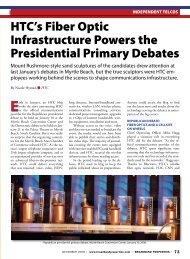March/April - Broadband Communities Magazine
March/April - Broadband Communities Magazine
March/April - Broadband Communities Magazine
You also want an ePaper? Increase the reach of your titles
YUMPU automatically turns print PDFs into web optimized ePapers that Google loves.
TeCHnology<br />
the Case for Vectoring<br />
A new technology that mitigates crosstalk on DSL networks now offers telcos<br />
a more graceful – and financially sustainable – transition to fiber.<br />
By Ariel Caner ■ ECI Telecom<br />
Not so long ago, wireline operators<br />
were leading the market<br />
with voice and Internet services<br />
and enjoying low customer churn. A lot<br />
has changed over the last several years.<br />
Consumer demand for high-bandwidth<br />
services is on the rise, and video is now<br />
one of the killer apps.<br />
Internet-connected TVs, over-thetop<br />
video, HDTV and video on demand<br />
are all contributing to a data explosion.<br />
These bandwidth-hungry services are<br />
pushing residential data rate demands to<br />
over 35 Mbps, with no end in sight. New<br />
3DTV and other rich media services are<br />
expected to bump this to more than 50<br />
Mbps in the not-too-distant future.<br />
This puts telcos in a difficult spot. It’s<br />
no secret that their current copper infrastructure<br />
has technology limitations<br />
that restrict it both rate- and distancewise.<br />
It simply can’t support very-highbandwidth<br />
services. However, a new<br />
copper-enhancement technology called<br />
vectoring adds to their range of options.<br />
THe opTIoNs<br />
Clearly, telcos must act and the sooner,<br />
the better. They have a couple of choices.<br />
Obviously, they can invest in new<br />
fiber plant. Fiber to the home is the<br />
ultimate solution for the long term because<br />
of its high capacity and low opex.<br />
However, although FTTH may be<br />
the best path forward for future-proof<br />
broadband access, many operators find<br />
themselves unable to execute a massive<br />
fiber deployment due to capex or resource<br />
constraints. FTTH can involve<br />
higher installation costs, end-user premises<br />
access issues (permits, digging) and<br />
multiyear deployment schedules, so for<br />
some telcos, building FTTH through-<br />
By processing and limiting the interference<br />
between copper pairs, vectoring offers<br />
performance that approaches the theoretical<br />
noise-free limit of VDSL2.<br />
out their service areas isn’t an economically<br />
feasible or near-term solution, as<br />
the ROI is still not there.<br />
Another option is to deploy a hybrid<br />
network: fiber to the access portion,<br />
terminating at the street cabinets, and<br />
copper from the street cabinets to the<br />
end users. This is a very cost-effective<br />
way to provide superfast rates, and the<br />
deployment time is much faster than<br />
with other methods. However, this approach<br />
involves running VDSL2 (veryhigh-speed<br />
DSL2) over the final few<br />
hundred meters of copper, and there are<br />
limitations to this technology. Although<br />
speeds of up to 100 Mbps are theoretically<br />
possible using VDSL2, in reality,<br />
because most access networks use copper<br />
deployed decades ago, the practical<br />
rate and reach are limited by crosstalk.<br />
Crosstalk is the electromagnetic interference<br />
caused by the simultaneous<br />
transmission of signals in copper pairs<br />
that are bundled together in a feeder<br />
cable, which can typically contain 100<br />
or more pairs. This noise can lead to in-<br />
64 | BROADBAND COMMUNITIES | www.broadbandcommunities.com | <strong>March</strong>/april 2012<br />
creased error rates and degradation in<br />
bandwidth, resulting in reduced rates<br />
over shorter distances from the customer<br />
premises.<br />
Given these alternatives, there’s a<br />
real need for innovative solutions. That’s<br />
where vectoring comes into play.<br />
INTroDUCING VeCTorING<br />
Developed by a group of top DSL researchers,<br />
vectoring – also known as<br />
dynamic spectrum management (DSM)<br />
Level 3 – is a technology that boosts<br />
the performance of copper to near fiber<br />
speeds, enabling higher-speed services<br />
to be provided over longer distances in<br />
existing copper access loops.<br />
Vectoring works by mitigating crosstalk.<br />
It processes and limits the interference<br />
that occurs between twisted copper<br />
pairs and, as a result, offers performance<br />
that approaches that of theoretical,<br />
noise-free VDSL2.<br />
The advancements brought about<br />
by the technology are impressive. For<br />
loop lengths shorter than 1,500 meters,<br />
about the author<br />
Ariel Caner is a product marketing manager in ECI Telecom’s Network Solutions Division<br />
with responsibility for product marketing activities related to ECI’s solutions.<br />
He can be reached at Ariel.Caner@ecitele.com. Learn more about ECI’s vectoring<br />
solutions at www.ecitele.com.



